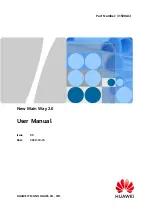
Commissioning and configuration
EP9224-0037
33
Version: 1.0
4.3.3
Undervoltage protection
The undervoltage protection prevents connected EtherCAT P devices from being operated with a supply
voltage that is too low. A malfunction of the EtherCAT P devices due to undervoltage is thus impossible.
The undervoltage protection has two threshold values, see
• U
warn
: A warning message is output if a supply voltage U
S
or U
P
falls below the upper threshold value
U
warn
.
• U
err
: If a supply voltage falls below the lower threshold value U
err
, all outputs are switched off and an
error message is output.
The threshold values of the undervoltage protection cannot be parameterized.
Deactivation for U
p
The undervoltage protection for the peripheral voltage U
P
can be deactivated in the CoE index F80E:05
"Disable Up Undervoltage Error". That is useful in applications in which U
P
is not needed. In such
applications U
P
would otherwise only have to be connected so as not to trigger the undervoltage protection.
Resetting an error state
If the output voltages have been switched off by the undervoltage protection, they can be re-activated in two
ways:
• a positive edge on the output variables
„DPO Inputs Device“ > „Global Reset“.
• A voltage reset (U
S
)
Requirement: Both supply voltages are higher at this point in time than the upper threshold value U
warn
.
4.3.4
Overtemperature protection
The overtemperature protection monitors the internal temperature of EP9224-0037.
It has two threshold values (see
):
• T
warn
: If the internal temperature exceeds T
warn
the box outputs a warning message.
• T
err
: If the internal temperature exceeds T
err
the box outputs an error message and switches all output
voltages off.
Resetting an error state
1. Allow the box to cool down until the internal temperature has fallen below T
warn
.
2. Apply a positive edge to the output variable
„DPO Outputs Device“ > „Global Reset“.
ð
The error message is reset.
ð
All output voltages are switched on again if no other protective function signals an error.














































